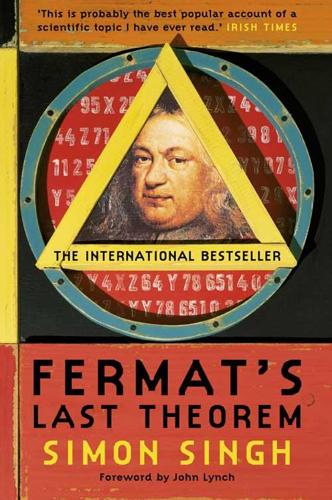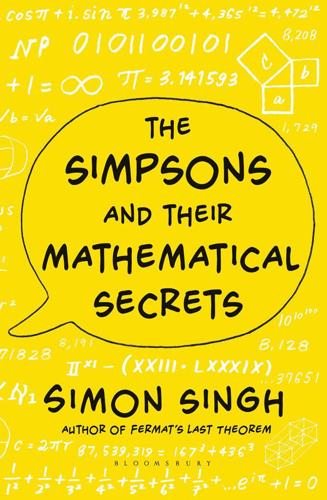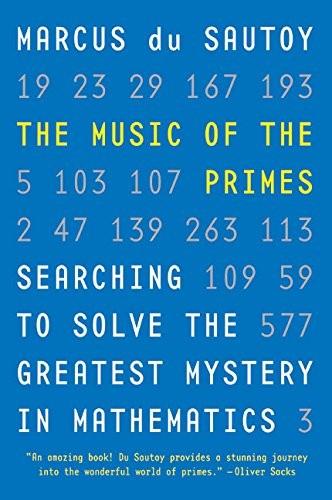
Fermat’s Last Theorem
by
Simon Singh
Published 1 Jan 1997
(9) If the Prize is not awarded by 13 September 2007, no ulterior claim will be accepted. The competition for the Wolfskehl Prize is open, as of today, under the above conditions. Göttingen, 27 June 1908 Die Königliche Gesellschaft der Wissenschaften It is worth noting that although the Committee would give 100,000 Marks to the first mathematician to prove that Fermat’s Last Theorem is true, they would not award a single pfennig to anybody who might prove that it is false. The Wolfskehl Prize was announced in all the mathematical journals and news of the competition rapidly spread across Europe. Despite the publicity campaign and the added incentive of an enormous prize the Wolfskehl Committee failed to arouse a great deal of interest among serious mathematicians.
…
The head of the mathematics department at Göttingen between 1909 and 1934 was Professor Edmund Landau and it was his responsibility to examine the entries for the Wolfskehl Prize. Landau found that his research was being continually interrupted by having to deal with the dozens of confused proofs which arrived on his desk each month. To cope with the situation he invented a neat method of off-loading the work. The professor printed hundreds of cards which read: Landau would then hand each new entry, along with a printed card, to one of his students and ask them to fill in the blanks. The entries continued unabated for years, even following the dramatic devaluation of the Wolfskehl Prize – the result of the hyperinflation which followed the First World War.
…
C. 166 Tokyo, international symposium (1955) 203 translational symmetry 196–7 trichotomy, law of 148 truels 167, 343 Turing, Alan Mathison 167–176 uncertainty principle 161–2 undecidability theorems 159–63 von Neumann, John 159, 167 Wagstaff, Samuel S. 176 Wallis, John 38, 42, 64 weighing problem 61, 337–8 Weil, André 160, 210 Weil conjecture see Taniyama–Shimura conjecture Weyl, Hermann 149 Whitehead, Alfred North 156 whole numbers 11 Wiener Kreis (Viennese Circle) 157 Wiles, Andrew xviii, 181, 224, 276, 302 adolescence and Fermat’s Last Theorem 5–6, 33, 77–8 graduate student days 180–81, 183 tackles elliptic equations 183, 184–5, 188, 189 and Taniyama–Shimura conjecture 215, 223, 225–31, 232, 258–61, 263–5, 274 uses Galois’s groups 251–3, 258, 296 announces proof of Fermat’s Last Theorem 1–2, 5, 33–5, 34, 266–72 reaction of media 272–4 mathematical celebrity 274, 290–91 submits proof for verification 277–9 proof flawed 279–91, 293, 296 proof revised 296–300 proof published 304–5 wins Wolf Prize 308 collects Wolfskehl Prize 308 and the future 309 Wiles, Nada 230, 265, 281, 298–9 Wolf Prize 306 Wolfskehl, Paul 132, 133–5 Wolfskehl Prize 135–7, 143–6, 268 Zagier, Don 254 zero, function of 58–9 About the Author FERMAT’S LAST THEOREM Simon Singh received his PhD from the University of Cambridge. A former BBC producer, he directed the BAFTA award-winning documentary film Fermat’s Last Theorem and wrote the best selling book of the same name.

The Simpsons and Their Mathematical Secrets
by
Simon Singh
Published 29 Oct 2013
According to some accounts, Wolfskehl despised his wife and the rest of his family, so his will was designed to snub them and reward mathematics, a subject that he had always loved. Others argue that the Wolfskehl Prize was his way of thanking Fermat, because it is said his fascination with the problem had given him a reason to live when he was on the verge of suicide. Whatever the motives, the Wolfskehl Prize catapulted Fermat’s last theorem into public notoriety, and in time it even became part of popular culture. In “The Devil and Simon Flagg,” a short story written by Arthur Porges in 1954, the titular hero makes a Faustian pact with the Devil.

The Music of the Primes
by
Marcus Du Sautoy
Published 26 Apr 2004
They are a classic selection. Clay’s seven million dollars is not the first time that money has been offered for solutions to mathematical problems. In 1997 Wiles picked up 75,000 Deutschmarks for his proof of Fermat’s Last Theorem, thanks to a prize offered in 1908 by Paul Wolfskehl. The story of the Wolfskehl Prize is what had brought Fermat to Wiles’s attention at the impressionable age of ten. Clay believes that if he can do the same for the Riemann Hypothesis, it will be a million dollars well spent. More recently, two publishing houses, Faber & Faber in the UK and Bloomsbury in the USA, offered a million dollars for a proof of Goldbach’s Conjecture as a publicity stunt to launch their publication of Apostolos Doxiadis’s novel Uncle Petros and Goldbach’s Conjecture.
…
., and Vértesi, P., ‘The mathematics of Paul Erdos’, Notices of the American Mathematical Society, vol. 45, no. 1 (1998), pp. 19–31 Babai, L., and Spencer, J., ‘Paul Erdos (1913–1996)’, Notices of the American Mathematical Society, vol. 45, no. 1 (1998), pp. 64–73 Barner, K., ‘Paul Wolfskehl and the Wolfskehl Prize’, Notices of the American Mathematical Society, vol. 44, no. 10 (1997), pp. 1294–1303 Beiler, A.H., Recreations in the Theory of Numbers: The Queen of Mathematics Entertains (New York: Dover Publications, 1964) Bell, E.T., Men of Mathematics (New York: Simon & Schuster, 1937) Berndt, B.C., and Rankin, R.A.
…
and Ramanujan 134, 135, 137–41, 143 and the Riemann Hypothesis 150, 160 Lobachevsky, Nikolai Ivanovic 110 logarithms 46–9, 55, 62, 72, 74, 91, 104, 105, 168, 189, 206 Logue, Donal 240 Louis XV, King of France 41 Louis XVI, King of France 41 Lovelace, Ada 190 Lucas, Édouard 205, 206 Lucas-Lehmer numbers 206, 207 m-commerce 248 Manasse, Mark 239 mathematics: a creative art under constraints 34 irrespective of race 184, 199 plunged into crisis 156 pursuit of order 6 Matijasevich, Yuri 198–9, 201 Mendeleev, Dmitri 23, 32, 36–7 Mendelssohn, Felix 75 Mersenne, Marin 40, 41, 44, 93, 204–5 Mersenne primes 17, 206–9, 224, 236 Mertens Conjecture 219, 221–2 Miller-Rabin test 245 Millennium Problems and Prizes 14–16, 33, 242, 246, 250, 252 Miller, Gary 245 Miller, Victor 248 Minkowski, Hermann 108, 114, 116, 211 MISPAR (a computer language) 4 modular arithmetic 9 Monbeig, M. 290 Montgomery, Hugh 254, 255–64, 267, 269–72, 275, 278, 307, 312 Mordell, Louis 258 Motchane, Léon 299, 303 music 77–9, 84, 125 ‘music of the spheres’ 77 of the primes 93–7, 310, 311 Riemann’s 278–9 Nachlass 151–153, 286–287 Napier, Baron John 46 Napoleon Bonaparte 17, 53, 57, 59, 60, 64, 78, 94, 96, 265, 266, 289, 299, 311 Nasar, Sylvia 304 Nash, John Forbes 304 National Bureau of Standards’ Institute for Numerical Analysis 207 National Physics Laboratory, Teddington, Middlesex 191 National Security Agency (NSA) (US) 12, 249 NATO 302 negative numbers 67–8, 68 neutrons 265, 268 Nevanlinna, Rolf 294 Neville, E.H. 139, 140–41 Newman, Max 183, 184, 186, 187, 191, 204,207 Newton, Sir Isaac 119, 123, 269 Noether, Emmy 194 non-communicative space of Adele classes 307 Norwegian Mathematical Society 157 Nth Fermat number 39 nucleus 264–5 Occam’s razor 215 Odlyzko, Andrew 220, 221–2, 221, 253, 254, 270, 271, 272, 275–6, 278, 279, 280, 312 Oppenheimer, Robert 263 parallel lines 109–10 particle accelerators 270 particle physics 4 partition function 143 partition numbers 141–3, 142, 158 Periodic Table of chemical elements 23, 32, 36, 224, 264, 265, 268 Peter the Great 41 physics 74, 84 pi (film) 28 Piazzi, Giuseppe 19 planetary orbits 188 Poincaré, Henri 1, 6 Pomerance, Carl 238–9, 240, 245 Prime Number Conjecture (later Theorem) see under Gauss, Carl Friedrich prime numbers: apparent randomness 5, 6, 7, 9, 47 and cicadas 27–8 definition 5 Fermat’s Little Theorem see under Fermat, Pierre de and Germany’s educational revolution 60 hunting for 38–41 importance to mathematics 5 infinity of 36, 76, 81, 106–7, 163, 205, 310 largest known 204, 205, 207, 208, 209 list of 5–6, 5, 22, 23, 24, 37, 199 and logarithms 46–9, 55, 62, 72, 74, 104, 105, 168, 206 and longevity 311–12 masters of disguise 130 music of 93–7, 310, 311 Riemann’s formula for the number of 89, 90–91, 90 story of primes as a social mirror 34 tables of 47–8, 48, 205–6 an unanswered riddle 314 probability theory 165, 166, 272, 313 Problem of the Bridges of Königsberg 43, 44, 106 Project Orion 263 protons 265, 268 Proust, Marcel 255 Prussia 59 Pryce, Maurice 187 Ptolemy I 36 Putnam, Hilary 198 Pythagoras 67, 77, 78, 93 Pythagoras’ theorem 67 quadratic sieve 238–9, 240 quantum billiards 275–80, 277, 282, 288 quantum chaos 279, 280, 281, 283, 298, 307, 311 quantum mechanics 279 quantum physics 4, 117, 166, 263, 264, 266, 267, 269, 273, 276, 280, 284, 286, 296, 305, 306, 307,311, 313 Rabin, Michael 245 Rademacher, Hans 158 Ramanujan, Srinivasa 27, 132–47, 133, 157–8, 164, 245, 262, 294 Ramanujan’s Tau Conjecture 16, 146 Rameau, Jean-Philippe 77 real numbers 68, 68, 69, 85 Redford, Robert 240 Reid, Legh Wilber 102 Ribenboim, Paulo 245 Riemann, Bernhard (main references) 63, 286–7 creates the Hypothesis 9 and Dirichlet 168 education 61–5, 72–5, 84 formula for number of primes 89, 90–91, 90 geometry 74, 113, 289, 307 imaginary numbers 66, 84, 88, 251, 286, 287 influences 61–2, 63, 66, 75–6, 82, 132 mathematical looking-glass 9, 90, 99, 167, 168 notebook 153–4 order out of chaos 97–101 paper on prime numbers 82–3, 84, 96, 100, 103, 106, 149, 150, 153 perfectionism 61, 82, 101 rescued notes 101, 151 Siegel discovers his secret formula 152–3, 213 succeeds Dirichlet 83, 100 visits Italy 100–101 and zeta function 81–2, 84–7, 137 Riemann, Elise (née Koch) 100, 101, 151 Riemann Hypothesis 33, 166, 176 assumed to be true 130, 131, 143 Bombieri’s interest see under Bombieri Cohen and 202 and commercial interest 11, 12 Connes’ work 3, 4, 288–289, 305, 307–9 Hilbert and 1–2, 114, 115, 243 importance 138–9 Landau’s criticism 149–50 a Millennium Problem 14, 15, 309–10, 312 probabilistic interpretation of 167 proof issue 4, 5, 9–10, 11, 14, 17, 18, 114–15, 159–60, 171–5, 178, 181, 182, 183, 188, 192, 196, 204, 212–16, 218–19, 222, 243, 245, 279, 281, 287, 288, 290, 294,297, 298, 301–2, 304, 307–10, 312,313 published 83 Selberg on 159–60, 173–4 Stieltjes’ claim 103 Rivest, Ron 11, 227–31, 229, 233–6, 238, 239, 242, 244, 249–50 Robinson, Julia 193–9, 195, 201, 202, 204, 205 Robinson, Raphael 196, 197, 207 Rota, Gian-Carlo 172 Royal Society 145, 189, 190 Computing Laboratory 191 RSA 12, 230, 231, 232, 235–9, 241–4, 246–50, 252, 253 ECC Central 249, 250 RSA 129 challenge 236–7, 239 RSA 155 challenge 240 Russell, Bertrand 128, 136, 138, 144, 178 Sacks, Oliver 8, 9, 39 Sagan, Carl 1, 7–8, 9, 28, 271, 280 Sarnak, Peter 127, 224, 281–3, 287, 296, 298, 307, 308, 309 Saxena, Nitin 245 Scandinavian Congress of Mathematicians (Copenhagen, 1946) 159 Schmalfuss (director of the Gymnasium Johanneum) 60–61, 63 Schneier, Bruce 242 Schoenberg, I.J. 154 Schrödinger, Erwin 284 Schwartz, Laurent 172 Science Museum, London 189 Second World War 154, 155–6, 160, 174, 175, 190, 192, 225, 241, 263, 289, 293–4 Selberg, trace formula 17 Selberg, Atle 16, 156–60, 157, 162, 167–74, 176, 177, 212–13, 261, 262, 263, 285, 288, 294, 295, 301–2, 307–8, 311–12 Severi, Francesco 296 Shamir, Adi 11, 228–9, 229, 230, 236, 238, 249 Shimura, Goro 298 Siegel, Carl Ludwig 148–9, 151–4, 156,188,213,251,297 Siegel zero 17 sieve of Eratosthenes 17, 23, 24, 239 Silverman, Joseph 250, 252, 253 sine function 72 sine waves 95, 96, 188 Skewes, Stanley 129, 130 Skewes Number 129 Slowinski, David 207, 208 Snaith, Nina 284, 285 Sneakers (film) 240, 242 Snow, C.P. 136–7, 147 space, as curved and non-Euclidean 128 spectroscopy 88, 224 Stalin, Joseph 293 Standards Western Automatic Computer (SWAC) 207 Stark, Harold 220, 221 Stieltjes, Thomas 102–5 string theory 306 super-symmetric fermionic-bosonic systems 4 Survive 303 Swinnerton-Dyer, Sir Peter 127, 250–52 Tarski, Alfred 197 te Riele, Herman 217, 218, 222 Teichmüller, Oswald 155 Thomson, J.J. 128 tides 188–9 Titchmarsh, Ted 188, 190, 192 triangular numbers 24–5, 26, 26, 29, 32, 52 trivial zeros 98 Trinity College, Cambridge 122–4, 124, 127–8, 144 Truman, Harry 172 Turán, Paul 169, 170 Turing, Alan 175–7, 177, 227 artificial intelligence 176 at Bell Laboratory 219 and the Enigma code 175, 190–91, 205, 206 and Hardy 187, 188 death 192 homosexuality 192 and the Riemann Hypothesis 175, 188, 191, 212 Turing machines 182–93, 197, 198, 199, 202–3, 204, 207, 213, 215 twin autistic-savants 8–9, 39 Twin Primes Conjecture 39, 181, 257, 258 uranium 268 van de Lune, Jan 219 Vernon, Dai 271–2 Vijayaraghavan 293, 294, 296 Wagner, Richard 59 Waring’s Problem 116 wave equation 266 Weber, Heinrich 154 Weber, Wilhelm 73–4 Weil, André 31, 180, 288–300, 293, 302, 305, 306, 308 Weyl, Hermann 160, 171 Wigner, Eugene 268–9, 270 Wiles, Andrew 4–5, 12–17, 29, 34, 115, 118, 171, 248, 251, 252, 282, 298, 313 William of Occam 215 Wittgenstein, Ludwig 128 Wolfskehl, Paul 15, 118 Wolfskehl Prize 15, 136 Woltman, George 208 Zagier, Don 213–19,214, 217, 252, 278 Zeilberger, Doron 309 zeta function 76–82, 84–6, 86, 88, 89, 128, 137, 144, 153, 158, 167, 168, 190, 220, 251, 258, 273, 283, 295 P.S. Ideas, interviews & features … About the Author * * * Portrait of Marcus du Sautoy Snapshot Top Ten Favourite Books About the Book * * * A Critical Eye Jerzy Grotowski Read On * * * If You Loved This, You’ll Like … Find Out More Bookshop About the Author Portrait of Marcus du Sautoy By Josh Lacey WHEN I MEET Marcus du Sautoy I take along one of the books which he discusses in The Music of the Primes and recommends in his ‘top ten’.